Auriol Z32171 User Manual [en, pl, cs]
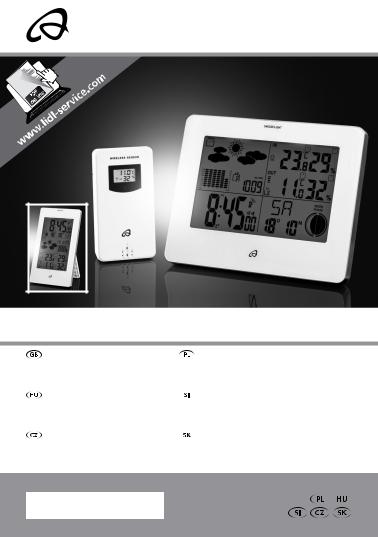
RADIO -CONTROLLED WEATHER STATION
RADIO-CONTROLLED |
STACJA METEO |
|
WEATHER STATION |
STEROWANA RADIOWO |
|
Operation and Safety Notes |
Wskazówki |
dotyczące obsługi i bezpieczeństwa |
RÁDIÓVEZÉRELT |
RADIJSKO VODENA |
|
IDŐJÁRÁSÁLLOMÁS |
VREMENSKA POSTAJA |
|
Kezelési és biztonsági utalások |
Navodila za upravljanje in varnostna opozorila |
|
BEZDRÁTOVÁ |
METEOSTANICA |
|
METEOROLOGICKÁ STANICE |
Pokyny pre obsluhu a bezpečnostné pokyny |
|
Pokyny pro obsluhu a bezpečnostní pokyny |
|
|
IAN 60107
GB |
Operation and Safety Notes |
Page |
8 |
PL |
Wskazówki dotyczące obsługi i bezpieczeństwa |
Strona |
30 |
HU |
Kezelési és biztonsági utalások |
Oldal |
54 |
SI |
Navodila za upravljanje in varnostna opozorila |
Stran |
77 |
CZ |
Pokyny pro obsluhu a bezpečnostní pokyny |
Strana |
101 |
SK |
Pokyny pre obsluhu a bezpečnostné pokyny |
Strana |
123 |
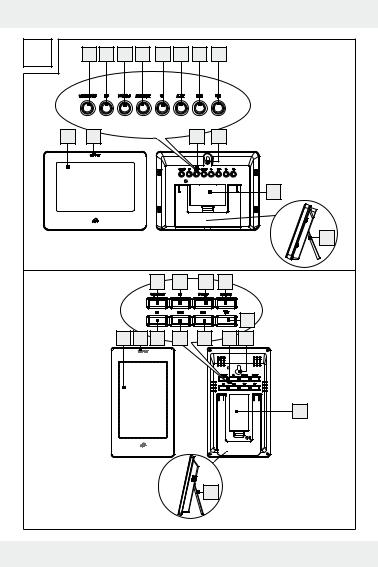
A |
13 |
14 |
15 |
16 |
17 |
18 |
19 |
20 |
Z32171A, |
|
Z32171B |
||||||||||
|
|
|
|
|
|
|
|
|||
1 |
2 |
|
|
|
|
|
3 |
4 |
|
|
|
|
|
|
|
|
|
|
|
5 |
|
|
|
|
|
|
|
|
|
|
6 |
|
|
|
|
|
|
13 |
14 |
15 |
16 |
Z32171C, |
|
|
|
|
|
|
|
|
|
|
Z32171D |
|
|
|
|
|
|
|
|
|
|
20 |
|
|
|
|
1 |
2 |
17 |
18 |
19 |
3 |
4 |
|
|
|
|
|
|
|
|
|
|
5 |
|
|
|
|
|
|
|
|
6 |
|
||
|
|
|
|
|
|
|
|
|
3 |
|

B |
25 |
8 |
9 |
10 |
|
|
|
|
11 |
|
|
|
|
11 |
4 |
|
|
|
|
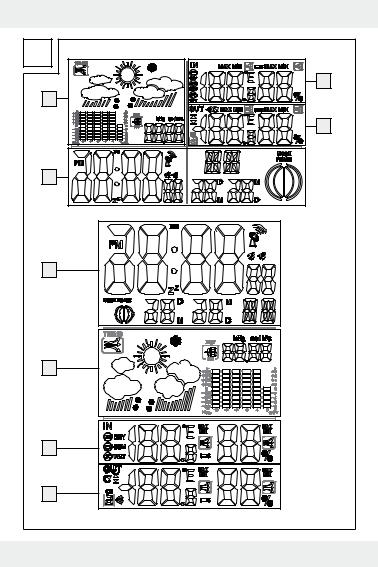
C |
Z32171A, |
Z32171B |
|
|
23 |
22 |
|
|
24 |
21 |
|
|
Z32171C, |
|
Z32171D |
21 |
|
22 |
|
23 |
|
24 |
|
|
5 |
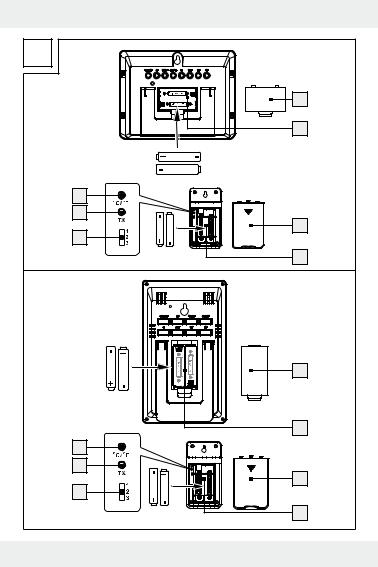
D |
Z32171A, |
Z32171B |
|
|
5 |
|
7 |
|
26 |
|
27 |
|
9 |
|
28 |
|
12 |
|
Z32171C, |
|
Z32171D |
|
5 |
|
7 |
|
26 |
|
27 |
|
9 |
|
28 |
|
12 |
6 |
|
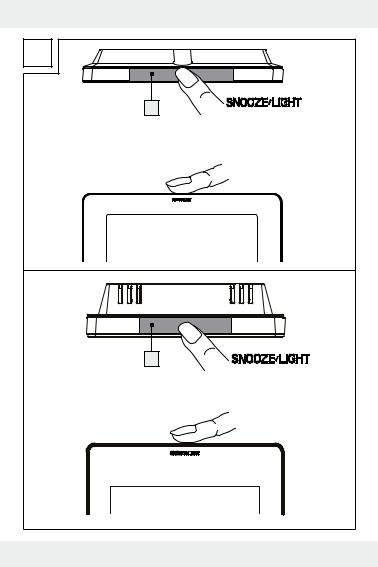
E |
Z32171A, |
Z32171B |
|
|
2 |
|
Z32171C, |
|
Z32171D |
|
2 |
|
7 |

Intended use............................................................................................. |
Page |
9 |
Parts description...................................................................................... |
Page |
9 |
Technical Data.......................................................................................... |
Page |
10 |
Scope of delivery.................................................................................... |
Page |
10 |
General safety instructions................................................................. |
Page |
11 |
Battery safety information................................................................. |
Page |
12 |
Start-up |
|
|
Setting up the devices............................................................................... |
Page |
13 |
Starting the outdoor sensor / changing batteries.................................... |
Page |
14 |
Starting the base station / changing batteries......................................... |
Page |
14 |
The DCF signal (time transmitter)............................................................. |
Page |
15 |
Information in base mode |
|
|
The clock field............................................................................................ |
Page |
16 |
The barometric pressure field................................................................... |
Page |
17 |
The indoor temperature field.................................................................... |
Page |
18 |
The outdoor temperature field.................................................................. |
Page |
20 |
Settings |
|
|
Basic settings............................................................................................. |
Page |
21 |
Temperature alarm.................................................................................... |
Page |
23 |
Activating the temperature alarm............................................................. |
Page |
24 |
Alarm......................................................................................................... |
Page |
24 |
Accessing stored data.............................................................................. |
Page |
26 |
Manually activating signal reception |
|
|
Activating DCF signal reception............................................................... |
Page |
26 |
Activating reception from the outdoor sensor......................................... |
Page |
26 |
Background lighting.................................................................................. |
Page |
27 |
Troubleshooting...................................................................................... |
Page |
27 |
Cleaning and Care.................................................................................. |
Page |
28 |
Disposal....................................................................................................... |
Page |
28 |
Declaration of Conformity................................................................... |
Page |
28 |
Warranty.................................................................................................... |
Page |
29 |
8 GB
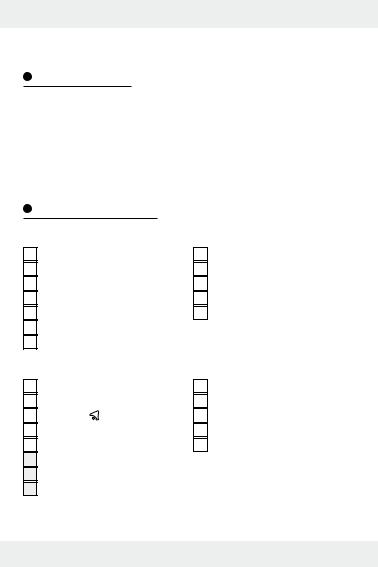
Radio-controlled weather station
Intended use
This radio-controlled weather station displays the indoor and outdoor temperature, indoor and outdoor humidity, and barometric pressure. It features a radio-controlled clock and several alarm functions. The probable weather trend is calculated based on data collected. The product is not intended for commercial use.
Parts description
Base station |
Outdoor sensor |
||
1 |
Display |
8 |
Signal LED |
2 |
SNOOZE- / LIGHT field |
9 |
Battery compartment cover |
3 |
Keypad |
10 |
Outdoor sensor eyebolt |
4 |
Base station eyebolt |
11 |
Outdoor sensor stand |
5 |
Battery compartment cover |
12 |
Outdoor sensor battery |
6 |
Stand |
|
compartment |
7 |
Battery compartment |
|
|
Keypad |
Display |
||
13 |
SET- / HISTORY button |
21 |
Clock field |
14 |
UP button |
22 |
Barometric pressure field |
15 |
DOWN- / button |
23 |
Indoor temperature field |
16 |
ALARM- / SET button |
24 |
Outdoor temperature field |
17 |
CH button |
25 |
Outdoor sensor display |
18ALERT button
19MEM button
20°C / °F button
GB 9
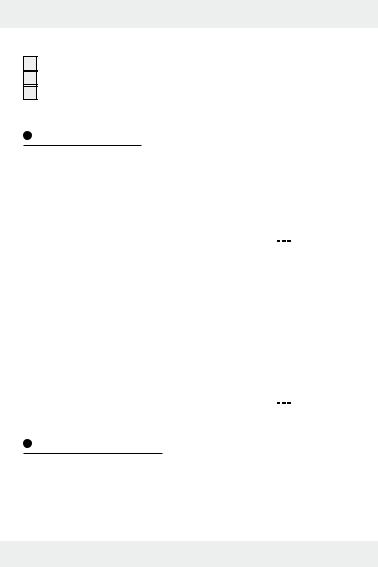
Outdoor sensor buttons next to battery compartment
26°C / °F button
27TX button (Channel reset button)
28Channel selector switch
Technical Data
Base station: |
|
|
|
|
Temperature measurement range: |
0 °C to 50 °C |
|
||
|
32 °F to 122 °F |
|
||
Humidity measurement range: |
20 % to 95 % |
|
||
Radio-controlled clock: |
DCF77 |
|
||
Batteries: |
2 x LR06, 1.5 V |
|
|
(size AA) |
|
||||
Barometric pressure |
|
|
|
|
measurement range: |
850 hPa to 1050 hPa |
|||
|
25.1 inHg to 31.1 inHg |
|||
Outdoor sensor: |
|
|
|
|
Temperature measurement range: |
-20 °C to +50 °C |
|
||
|
-4.0°F to + 122 °F |
|
||
Humidity measurement range: |
20 % to 95 % |
|
||
Data transmission frequency: |
433 MHz |
|
||
Wireless range: |
max. 100 m (open area) |
|||
Batteries: |
2 x LR06, 1.5 V |
|
|
(size AA) |
|
||||
Scope of delivery
1 Weather station
1 Outdoor sensor
4 Batteries, type LR06, 1.5 V
1 Set of operating instructions
10 GB

 General safety instructions
General safety instructions
Before using the product, please familiarise yourself with all of the safety information and instructions for use! When passing this product on to others, please also include all the documents!
This product may be used by children 
 age 8 years and up, and persons with reduced physical, sensory or mental capacity or lacking experience and knowledge, when supervised or instructed on the safe use of the
age 8 years and up, and persons with reduced physical, sensory or mental capacity or lacking experience and knowledge, when supervised or instructed on the safe use of the
product and the associated risks. Children should not be allowed to play with the appliance. Cleaning and user maintenance should not be performed by children without supervision.
Do not use the device if it is damaged.
Do not expose the base station to moisture or direct sunlight.
GB 11
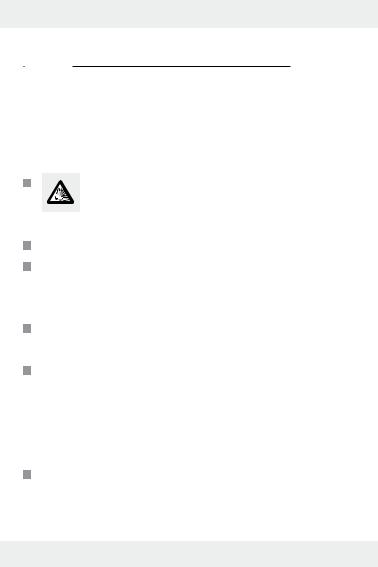
 Battery safety information
Battery safety information 
 DANGER TO LIFE!
DANGER TO LIFE!
Batteries are not intended for children. If accidentally swallowed seek immediate medical attention!
CAUTION! EXPLOSION HAZARD!
Never recharge non-rechargeable batteries, short-circuit and / or open batteries! Never throw batteries into fire or water!
Do not exert mechanical loads to batteries!
Risk of battery leakage
In the event of a battery leak, immediately remove it from the device to prevent damage!
Avoid contact with the skin, eyes and mucous membranes! In the event of contact with battery acid, thoroughly flush the affected area with plenty of clean water and seek immediate medical attention!
Only use the same type of batteries! Do not mix used and new batteries!
12 GB
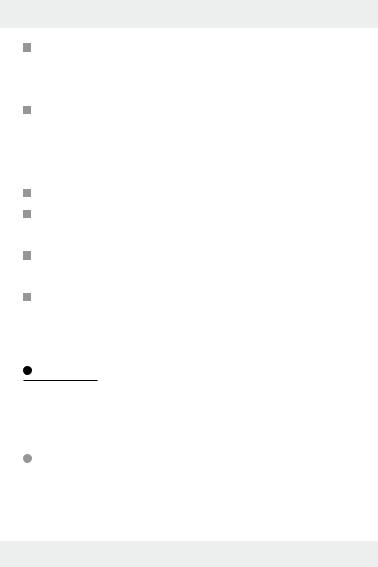
Avoid extreme environmental conditions and temperatures as they may affect batteries e.g. above radiators!
Remove the batteries from the device if they have not been used for a long period!
Risk of equipment damage
Only use the specified battery type!
When inserting the battery ensure the correct polarity! This is shown in the battery compartment!
If necessary, clean the battery and device contacts before inserting the battery! Promptly remove drained batteries from the product!
Start-up
Note: First insert the batteries in the outdoor sensor, then the weather station.
Setting up the devices
ATTENTION: First start the outdoor sensor, then the base station.  If possible, do not expose the outdoor sensor or base station to
If possible, do not expose the outdoor sensor or base station to
direct sunlight.
GB 13
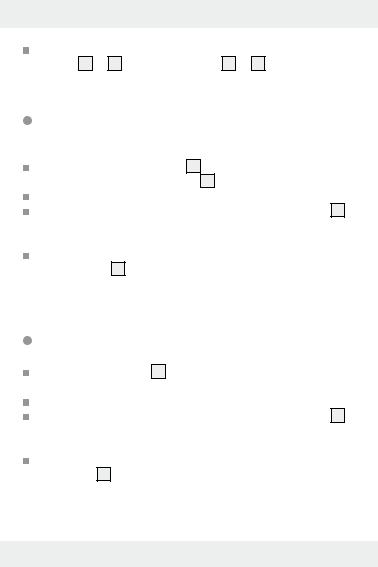
The base station as well as the outdoor sensor can be hung by the eyebolt 4 or 10 . Or flip out the stand 6 or 11 on either device to place the device on a horizontal, level surface.
Starting the outdoor sensor / changing batteries
Open the battery compartment 12 on the back of the outdoor sensor by sliding the battery cover 9 in the direction of the arrow. When changing batteries first remove the old batteries.
Insert the new batteries, type LR06, in the battery compartment 12 . Check the polarity of the battery during insertion. This is indicated in the battery compartment.
Close the battery cover.
The signal LED 8 at the front of the outdoor sensor will briefly light up. The signal LED will then flash about twice a minute, indicating wireless transmission.
Starting the base station / changing batteries
Open the battery cover 5 at the back of the base station by pulling up on the tab at the bottom of the battery compartment.
When changing batteries first remove the old batteries.
Insert the new batteries, type LR06, in the battery compartment 7 . Check the polarity of the battery during insertion. This is indicated in the battery compartment.
Close the battery cover.
The display 1 will briefly light up and run a brief check of all display elements.
14 GB
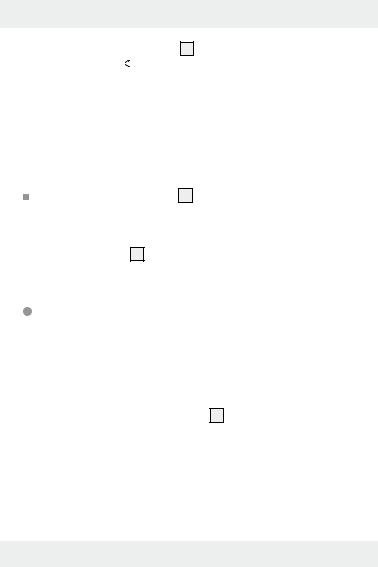
The outdoor temperature field 24 will show an animation of the reception symbol 
 , indicating the base station is searching for the signal from the outdoor sensor.
, indicating the base station is searching for the signal from the outdoor sensor.
If no outdoor temperature is displayed after 3 minutes,the base station will stop searching. The animation of the reception symbol will turn off and the outdoor temperature field will show --._ °C and --._ %. Most likely, the signal cannot be received due to structural factors, reinforced concrete walls, the brickwork being too solid, or the distance between the units. After finding a better location for the outdoor sensor, reception will need to be restarted.
Press and hold the CH button 17 at the back of the base station for 3 seconds until the reception signal becomes animated again.
The weather station will automatically start receiving the DCF radio signal, regardless if signal from the outdoor sensor was received or not. The clock field 21 will show an animated radio tower icon  , indicating the receiver for the DCF signal is starting to receive the time.
, indicating the receiver for the DCF signal is starting to receive the time.
The DCF signal (time transmitter)
The DCF signal (German time transmission station) consists of time impulses emitted by one of the most accurate clocks in the world, located near Frankfurt / Main, Germany.
In ideal conditions, your weather station can pick up this signal over a distance of up to approx. 1500 km around Frankfurt / Main.
If the signal is detected the clock display 21 will show the current Central European Time, date and day of the week. A static radio tower signal  appears. For more details please refer to section Basic settings.
appears. For more details please refer to section Basic settings.
If the attempts to receive a signal fail the base station will stop attempting to receive a signal after 7 minutes and the radio tower signal  will disappear. For information on how to resolve this issue please refer to chapter Troubleshooting.
will disappear. For information on how to resolve this issue please refer to chapter Troubleshooting.
GB 15
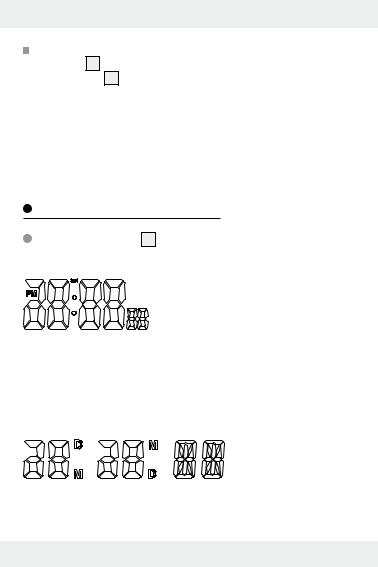
You may reactivate reception by pressing and holding the DOWN-/  button 15 for three seconds until an radio tower signal
button 15 for three seconds until an radio tower signal  in the clock display 21 becomes animated.
in the clock display 21 becomes animated.
You also have the option to set the time manually. For more details please refer to section Basic settings.
Once the base station has received the signal from the outdoor sensor and the DCF signal, it enters base mode.
In base mode the base station will display the following information:
Information in base mode
The clock field 21
Time:
The time will be displayed in 24 hour format according to the default settings.
When selecting 12 hour mode in basic settings, the time from 12:00 o‘clock in the
afternoon until 11:59 o‘clock at night will show PM (Latin for „post meridiem“ = afternoon) in front of the time.
During Daylight Saving Time DST will appear at the top between the hour and minute. This display is only functional when receiving the DCF signal.
Date and day:
To the left of the abbreviation D (Day) the date of the current day appears,
and to the left of the abbreviation M (month) the date of the current month. On the right the abbreviation for the current day of the week
16 GB
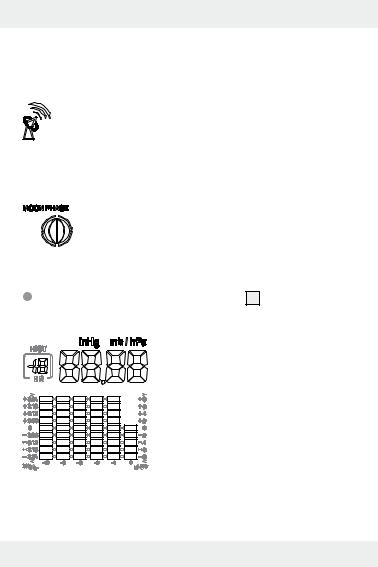
appears. The default language for this abbreviation is German, but can be changed. Please refer to section Basic settings.
The radio tower symbol:
The radio tower symbol indicates successful reception of the DCF signal. The weather station synchronises its internal clock with the time station every night. During synchronisation this sym-
bol will flash. If reception was successful the symbol will be static until the next reception cycle.
The lunar phase:
The current lunar phase is indicated as follows:
The portion of the moon not illuminated will be dark in the display.
The barometric pressure field 22
Barometric pressure display:
At the top right is the barometric pressure at the time shown in the HIST field (history).
If LLL (or LL.LL when setting the unit inHg),
the display range is below 850 hPa
(25.1 inHg), if HHH (or HH.HH), it is above.
By default the current barometric pressure
(HIST = 0) is shown in the unit mb (millibar)
or hPa (hectopascal). However, the display can also be set to the uncommon unit inHg
(inch of mercury). Please refer to section Basic settings.
The bar graph shows a graphic of the barometric pressure 0, 1, 2, 3, 6 and 12 hours ago.
GB 17
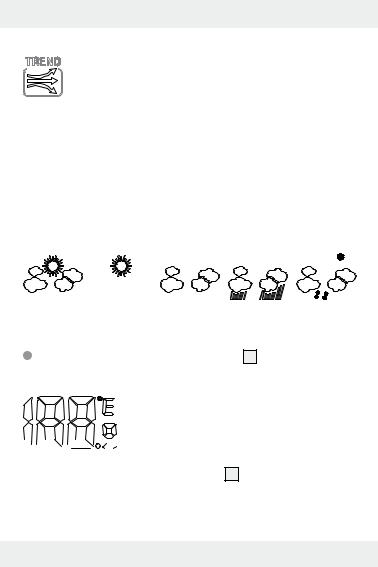
The barometric pressure trend:
The trend will appear as rising (or dropping), when the baro-
metric pressure changes by 2 hPa (= 0.06 inHg) or more within an hour and will maintain the direction for one hour
even without any further change.
The weather forecast:
The weather station calculates a weather forecast for about the next
12 hours based on the barometric pressure trend. Of course this forecast can‘t compare to that of professional weather services supported by satellites and high performance computers, but merely provides an approximate indication of current developments.
Available graphic forecasts are:
slightly cloudy sunny cloudy rainy snow
The indoor temperature field 23
The indoor temperature:
The indoor temperature measured by the base sta-
tion is displayed with indexing up to a tenth of a
degree. The temperature unit °C (for degrees Cel-









 sius) appears at the top right. The temperature unit can also be set to the now uncommon unit °F (degrees Fahrenheit).
sius) appears at the top right. The temperature unit can also be set to the now uncommon unit °F (degrees Fahrenheit).
To change to this unit press the °C/F button 20 . If LL.L appears, it is below the measurement range of 0 °C to 50 °C (or 32 °F to 122 °F), when HH.H appears it is above.
18 GB
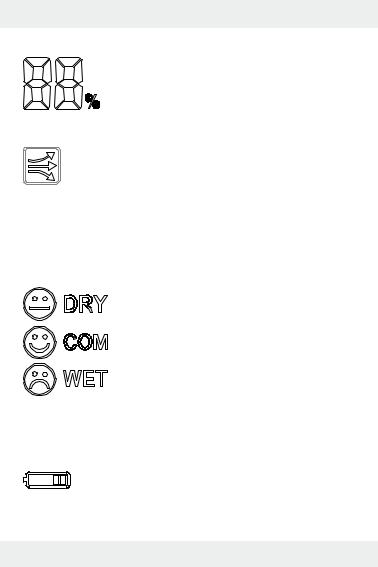
The relative humidity:
This displays the relative humidity to which the base station is exposed.
The temperatureor humidity trend:
The trend will appear as rising (or dropping), when the tem-
perature changes by 2°C(=3.6°F)or more within an hour and will maintain the direction for one hour even without any
further change. The humidity trend will respond accordingly with a change of 2 % in humidity.
Indoor climate rating:
Based on the indoor humidity and temperature the weather station will rate the indoor climate using the following key:
DRY humidity below 40 %
COMFORT humidity between 40 and 70 %, and a temperature range between 20 °C–28 °C (68 °F–82.4 °F).
WET humidity higher than 70%
When the indoor temperature is outside the 20 °C–28 °C range no indoor climate rating will appear.
Low battery:
If the battery symbol appears the batteries in the base station should be replaced as soon as possible. Please refer to
the instructions in section Starting the base station / changing batteries.
GB 19
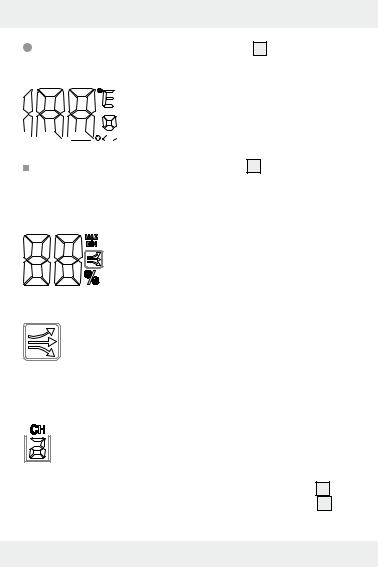
The outdoor temperature field 24
The outdoor temperature:
The outdoor temperature is displayed with index-
ing up to a tenth of a degree. The temperature
unit °C (for degrees Celsius) appears at the top









 right. The temperature unit can also be set to the now uncommon unit °F (degrees Fahrenheit).
right. The temperature unit can also be set to the now uncommon unit °F (degrees Fahrenheit).
To change to this unit press the °C / F button 20 .
If LL.L appears, it is below the measurement range of -20 °C to 50 °C (or - 4 °F to 122 °F), when HH.H appears it is above.
The relative humidity:
This displays the relative humidity to which the outdoor sensor is exposed.
The temperatureor humidity trend:
The trend will appear as rising (or dropping), when the tem-
perature changes by 2 °C(=3.6 °F)or more within an hour and will maintain the direction for one hour even without any
further change. The humidity trend will respond accordingly with a change of 2 % in humidity.
Channel display:
The weather station receives the outdoor signal automati-
cally after you have made all the settings.
Note: In the event of interference from nearby equipment transmitting radio signals, please select a different channel for the outdoor sensor by pressing the CH button 17 on the weather station or the channel selector switch 28 on
20 GB
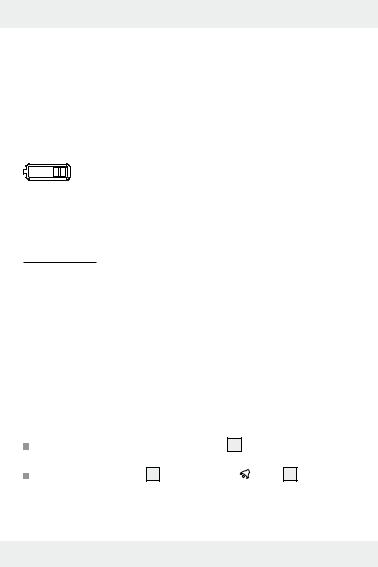
the outdoor sensor. The relevant data is shown in the LC-display.
-1: Outdoor sensor channel 1
-2: Outdoor sensor channel 2
-3: Outdoor sensor channel 3
- : automatic channel change
: automatic channel change
Low battery:
If the battery symbol appears the batteries in the outdoor sensor should be replaced as soon as possible. Please refer
to the instructions in section Starting the outdoor sensor / changing batteries.
 Settings
Settings
ATTENTION: Firmly touching the top of the housing will turn on the backlight (Fig. E). Five seconds after releasing it the display backlight will turn off again.
Please note, the base station does not respond to two buttons being pressed at once. Hence, if the unit does not respond to a button being pressed, you are probably also pressing the SNOOZE/LIGHT field. Release when this occurs!
 Basic settings
Basic settings
Press and hold the SET/HISTORY button 13 for 3 seconds to change the basic settings.
Pressing the UP button 14 or the DOWN- / -button 15 allows you to now change the respective flashing value.
GB 21
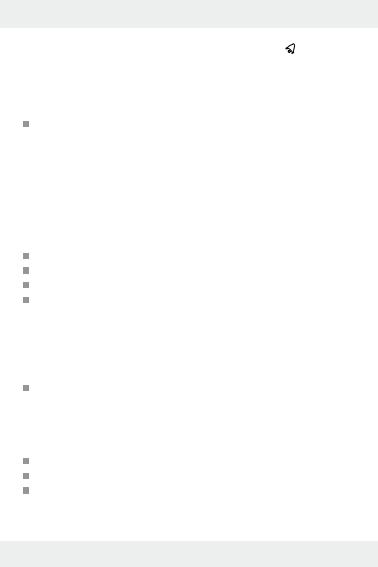
TIP: Pressing and holding the UP button or the DOWN- / -button will quickly scan ahead or back through the numbers.
ATTENTION: When no buttons are pressed for approx. 20 seconds the base station will return to base mode.
Briefly pressing the SET/HISTORY button will confirm the setting and switch to the next option in the clock settings.
This allows you to change the following settings in sequence:
Note: If the weather station has received the DCF signal the year, month, day, hour and minute settings will remain unchanged. If you are in a different time zone than Germany you may set your local time under time zone.
Year
Month Day
Language setting for displaying the weekday at the bottom right of the clock display.
The following codes will flash and can be changed in the following sequence by pressing the UP / DOWN button: DE (German),
DA (Danish), ES (Spanish), NE (Dutch), FR (French), IT (Italian), EN (English)
Clock format: select from 24 Hr for 24-hour format
(0:00 o‘clock–23:59 o‘clock). 12 Hr indicates the 12-hour format (1:00 o‘clock–12:59 o‘clock). In 12-hour mode the time from 12:00 o‘clock in the afternoon until 11:59 o‘clock at night will show PM (Latin for „post meridiem“ = after noon) in the display.
Hour
Minute
Time zone: The time zone can be set ranging from +12 to –12 hours. The reference time is Central European Time. Reception of the DCF signal will automatically switch to daylight saving time.
22 GB
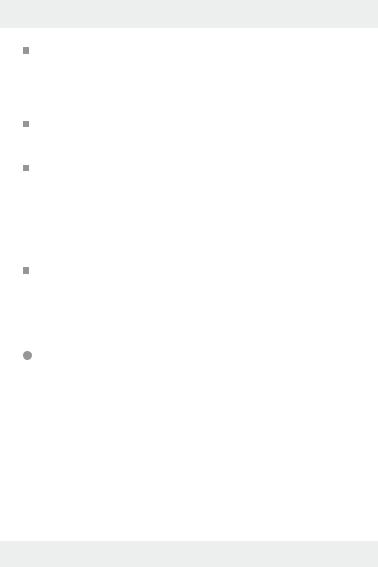
Weather forecast: The weather station computes the weather forecast based on changes in the barometric pressure. Since no data related to barometric pressure changes is available when starting the unit, the weather forecast will be random at this time. The weather station will only be able to compute the forecast after a few days. However, when starting the unit you may use the UPor DOWN- /  -button to set a forecast based on the forecast on the TV or the internet to slightly accelerate self-regulation of the weather forecast.
-button to set a forecast based on the forecast on the TV or the internet to slightly accelerate self-regulation of the weather forecast.
Setting the barometric pressure: The barometric pressure will indicate the absolute barometric pressure in mb,or hPa according to the default setting. Here you may now set the display to the altitude-re- lated barometric pressure of your location. Please obtain the correct current data from the internet or the local weather forecast. Please note, the data must be entered in the unit displayed at the time the setting is made.
Setting the barometric pressure: The default is the official European unit hPa. However, you may also select the unit inch of mercury (inHg). When changing the unit at this time the indicated value will automatically be converted to the new unit.
Temperature alarm
You have the option to define a temperature range for the outdoor sensor. With the temperature alarm activated, the base station will sound an alarm if the outdoor sensor measures a temperature outside of this temperature range.
GB 23
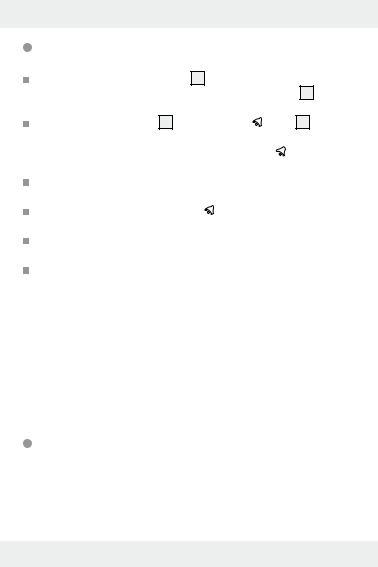
Activating the temperature alarm
Press and hold the ALERT button 18 for three seconds until the temperature display flashes in the outdoor temperature field 24 . A flashing up arrow ▲ will appear to the left of the temperature.
Now press the UP button 14 or the DOWN- / -button 15 to set the maximum temperature for the desired temperature range.
TIP: Press and hold the UP button or the DOWN- / -button to quickly scan ahead or back through the numbers.
Confirm the value by pressing the ALERT button. The temperature display will now flash again and a down arrow ▼ will start flashing. Press the UP button or the DOWN- / -button to now set the minimum temperature for the desired temperature range.
Confirm the value by pressing the ALERT button. The temperature range is now set.
Briefly press the ALERT button to now activate or deactivate the temperature alarm.
With the temperature alarm activated a static double arrow will appear in the outdoor temperature field below OUT: 
If the outdoor sensor measures a temperature outside this temperature range the base station will sound an alarm for one minute. This alarm can be silenced by pressing any button on the keypad.
The temperature which triggered the alarm will flash as a visual alarm, and the part of the double arrow indicating the direction of the temperature deviation. Press the ALERT button to switch off the alarm.
Alarm
The weather station features two alarms, which can be set and activated separately.
24 GB
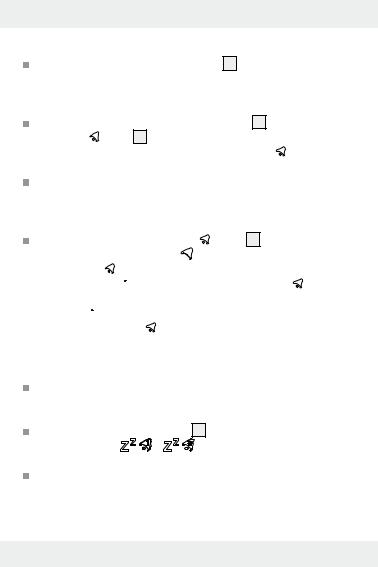
Setting the alarm
Press and hold the ALARM-/SET button 16 for 3 seconds to enter the alarm settings mode. The last alarm setting will appear in place of the clock, with the hour flashing. The mark A1 will appear to the right of the alarm time.
Set the hour for alarm A1 using the UP button 14 or the DOWN- / -button 15 .
TIP: Press and hold the UP button or the DOWN- / -button to quickly scan ahead or back.
Press the ALARM-/SET button again to confirm your entry, and he minutes will start flashing. These can be changed in the same manner.
Activating the alarm
In clock mode press the DOWN- / -button 15 . In addition to the time a bell will appear with 1:  . Alarm 1 is now activated. Press the DOWN- / -button again and the alarm symbol 1 will disappear. Alarm symbol 2:
. Alarm 1 is now activated. Press the DOWN- / -button again and the alarm symbol 1 will disappear. Alarm symbol 2: .will appear. Pressing the DOWN- / -button again will activate alarm 1 and alarm 2. Both alarm symbols will appear:
.will appear. Pressing the DOWN- / -button again will activate alarm 1 and alarm 2. Both alarm symbols will appear:

Pressing the DOWN- / -button a fourth time will deactivate both alarm 1 and alarm 2.
Switching off the alarm
The alarm will sound at the set time and the backlight will switch on. When not switched off, the alarm will sound for 2 minutes before stopping automatically.
Press the SNOOZE-/LIGHT field |
2 to interrupt the alarm. The clock |
|
display will flash |
/ |
, indicating the snooze function has |
been activated: the alarm will sound again after 5 minutes. Press any button on the keypad to actually shut off the alarm.
GB 25
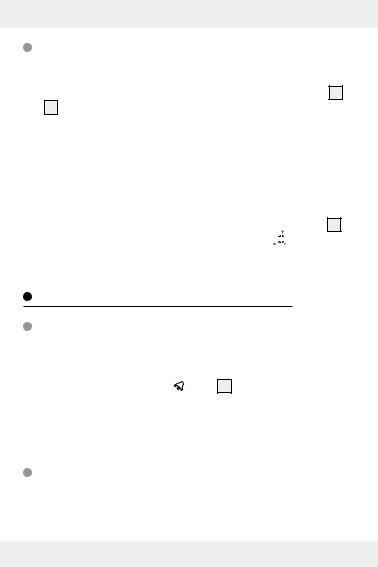
Accessing stored data
Maximum temperatures
Press the MEM button again and both temperature fields will show 23 and 24 next to the temperature, and MAX next to the humidity. The respective maximum indoor and outdoor value will be shown. Press the MEM button twice and MIN will appear next to the temperature, and the respective lowest indoor and outdoor value will be shown. After 5 seconds the current values will again be displayed.
Barometric pressure history
Repeatedly briefly pressing the SET-/HISTORY button will display the barometric pressure for the past 12 hours. The barometric pressure field 22 next to the display of the barometric pressure the history 

 indicates how many hours ago the barometric pressure being displayed was current.
indicates how many hours ago the barometric pressure being displayed was current.
Manually activating signal reception
Activating DCF signal reception
Every night the base station synchronises the internal clock with the DCF signal. However, you may also activate DCF reception manually. To do so, press and hold the DOWN- / -button 15 for 3 seconds until the radio tower symbol  flashes. Following successful reception the radio tower symbol will be static. If reception fails, the radio tower symbol will disappear.
flashes. Following successful reception the radio tower symbol will be static. If reception fails, the radio tower symbol will disappear.
Activating reception from the outdoor sensor
The outdoor sensor will transmit a signal about twice a minute, which is automatically received by the base station. However, you may also
26 GB
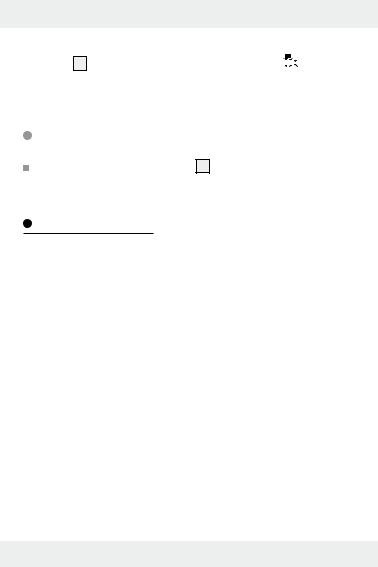
manually activate reception of the signal. To do so, press and hold the CH button 17 for three seconds until the channel symbol 

 flashes. Following successful reception the animation of the symbol will disappear and the transmitted temperature and humidity will appear in the display.
flashes. Following successful reception the animation of the symbol will disappear and the transmitted temperature and humidity will appear in the display.
Background lighting
Touch the SNOOZE-/LIGHT field 2 . The backlight illuminates for 5 seconds.
Troubleshooting
The device contains delicate electronic components. Thus radio transmitting equipment in the immediate vicinity may interfere with the appliance. If the display shows interference, move such objects away from the weather station. Electrostatic discharges can lead to malfunctions.
In cases of the appliance failing to work, remove the batteries for a short while and then replace them.
Obstacles, e.g. concrete walls, may make the reception susceptible to interference. In this event change the location. Please note, the outdoor sensor should always be set up within a range of max. 100 metres (open area) of the base station. The specified range is the open area range, meaning there should be no obstructions between the outdoor sensor and the base. „Visual contact“ between the outdoor sensor and the base will often improve transmission.
Cold (outdoor temperatures below 0 °C) may also negatively impact battery performance of the outdoor sensor, thus wireless transmission. Another factor which may interfere with reception is drained or weak batteries in the outdoor sensor. Replace these with fresh batteries.
If the weather station is not working properly, briefly remove and reinsert the batteries.
GB 27

Cleaning and Care
Never immerse the product in water or other liquids. Otherwise the product can be damaged.
Use a dry, soft and lint-free cloth for cleaning and care.
Disposal
Pb
The packaging is made of environmentally friendly materials, which may be disposed through your local recycling facilities.
When your device has come to the end of its life, in the interest of environmental protection please do not throw it out with your household refuse, but take it to a suitable centre where it can be disposed of properly. Please contact your local authority for information on collection points and their opening hours.
Never dispose of batteries in your household waste. They may contain toxic heavy metals and are subject to hazardous waste regulations. The chemical symbols of the heavy metals are: Cd = cadmium, Hg = mercury, Pb = lead. Therefore dispose of used batteries through your municipal collection site.
Declaration of Conformity
We, OWIM GmbH & Co. KG, Stiftsbergstraße 1, D-74167 Neckarsulm, hereby declare under our sole responsibility the product: radio-controlled weather station, Model no.: Z32171A, Z32171B, Z32171C, Z32171D, Version: 06/2014, to which the declaration refers, complies with the standards/normative documents of 1999 / 5 / EC. If necessary, these documents may be downloaded from www.owim.com.
28 GB
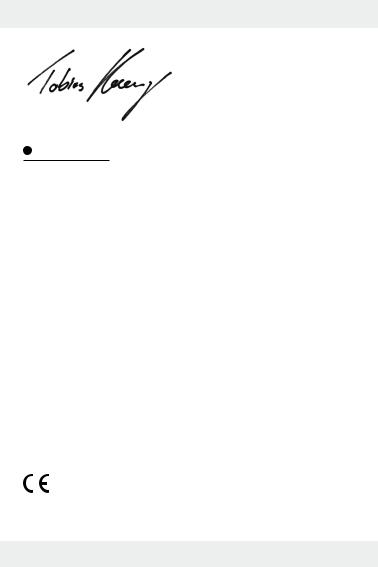
Warranty
The device has been manufactured to strict quality guidelines and meticulously examined before delivery. In the event of product defects you have legal rights against the retailer of this product. Your legal rights are not limited in any way by our warranty detailed below.
The warranty for this device is 3 years from the date of purchase. Should this device show any fault in materials or manufacture within 3 years from the date of purchase, we will repair or replace it – at our choice – free of charge to you.
The warranty period begins on the date of purchase. Please keep the original sales receipt in a safe location. This document is required as your proof of purchase. This warranty becomes void if the device has been damaged or improperly used or maintained.
The warranty applies to faults in material or manufacture. This warranty does not cover product parts subject to normal wear, thus possibly considered consumables (e.g. batteries) or for damage to fragile parts, e.g. switches, rechargeable batteries or glass parts.
GB 29

Zastosowanie zgodne z przeznaczeniem................................. |
Strona |
31 |
Opis części............................................................................................... |
Strona |
31 |
Dane techniczne.................................................................................... |
Strona |
32 |
Zakres dostawy................................................................................... |
Strona |
32 |
Ogólne wskazówki dot. bezpieczeństwa................................ |
Strona |
33 |
Wskazówki dotyczące bezpieczeństwa |
|
|
związane z bateriami........................................................................ |
Strona |
34 |
Uruchomienie |
|
|
Ustawianie urządzeń............................................................................. |
Strona |
36 |
Uruchamianie czujnika zewnętrznego / wymiana baterii................... |
Strona |
36 |
Uruchamianie stacji głównej / wymiana baterii................................... |
Strona |
37 |
Sygnał DCF (nadajnik czasu zegarowego)......................................... |
Strona |
38 |
Komunikaty w trybie podstawowym |
|
|
Pole czasu zegarowego........................................................................ |
Strona |
39 |
Pole ciśnienia atmosferycznego............................................................ |
Strona |
40 |
Pole temperatury wewnątrz................................................................... |
Strona |
41 |
Pole temperatury na zewnątrz.............................................................. |
Strona |
43 |
Ustawienia.............................................................................................. |
Strona |
44 |
Ustawienia podstawowe....................................................................... |
Strona |
45 |
Alarm temperatury................................................................................. |
Strona |
47 |
Ustawienie alarmu temperatury............................................................ |
Strona |
47 |
Alarm budzika........................................................................................ |
Strona |
48 |
Pobieranie zapisanych danych............................................................. |
Strona |
49 |
Manualna aktywacja odbioru sygnału |
|
|
Aktywacja odbioru sygnału DCF.......................................................... |
Strona |
50 |
Aktywacja odbioru sygnału czujnika zewnętrznego........................... |
Strona |
50 |
Podświetlenie.......................................................................................... |
Strona |
50 |
Usuwanie błędów............................................................................... |
Strona |
50 |
Czyszczenie i pielęgnacja................................................................. |
Strona |
51 |
Utylizacja................................................................................................. |
Strona |
52 |
Deklaracja zgodności......................................................................... |
Strona |
52 |
Gwarancja.............................................................................................. |
Strona |
53 |
30 PL
